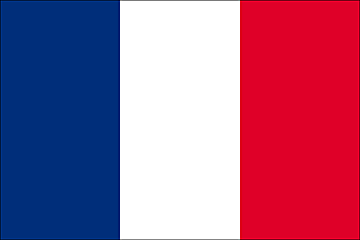Via Bruno Buozzi n. 18 - 00015 Monterotondo (RM)
Tel. 0690627227 - Fax 0690626117
E-mail rmic88200c@istruzione.it - PEC rmic88200c@pec.istruzione.it
Tel. 0690627227 - Fax 0690626117
E-mail rmic88200c@istruzione.it - PEC rmic88200c@pec.istruzione.it
Tu sei qui
Monterotondo (inglese)
THE LOCATION
 Monterondo is located in the centre of Lazio in central Italy, 30 km far from Rome and it is divided into:
Monterondo is located in the centre of Lazio in central Italy, 30 km far from Rome and it is divided into:• Upper Monterondo
• Monterotondo Scalo
Monterotondo is characterized by hills that do not exceed the altitude of 150 mt, with vineyards and olive groves. Monterotondo is crossed by Tevere river. The weather is mild in the winter and in the summer.
In Monterotondo there are lots of shops and facilities, for example:
• a few post offices;
• some supermarkets;
• some bakeries;
• a few restaurants;
• the library.
Now we are going to visit the Dome, Orsini Palace, the arch of San Rocco and Piazza dei Leoni and then we’ll talk about some typical celebrations and recipes of Monterotondo.
THE MONUMENTS
The Dome
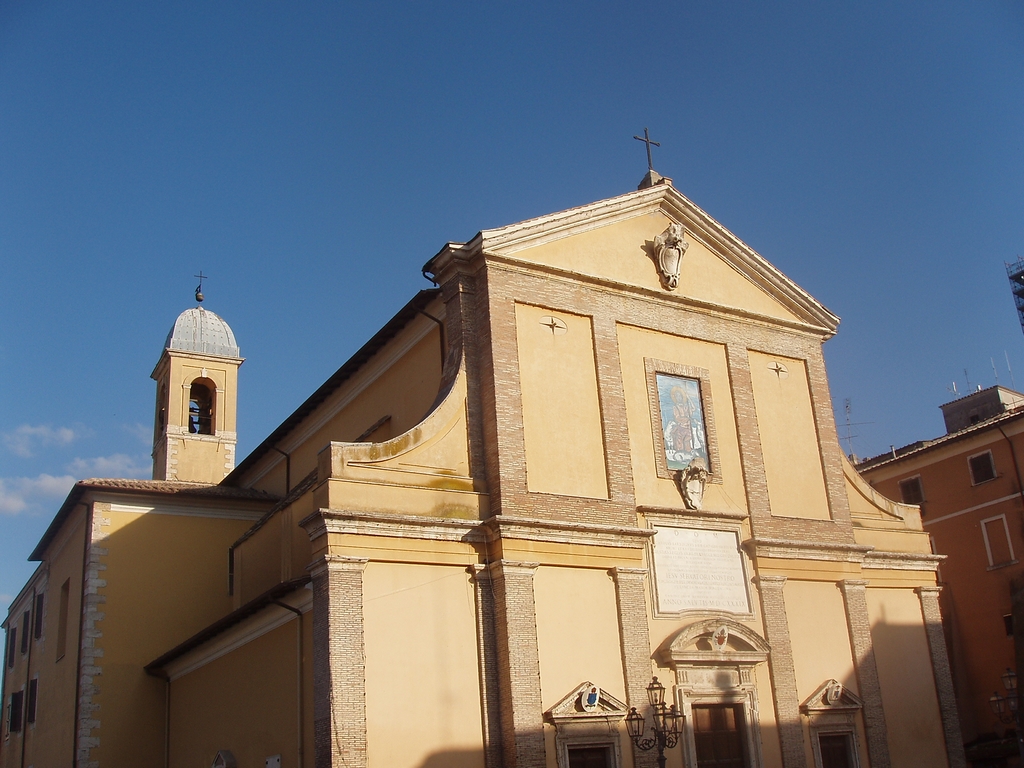 In 1621 the “Council of the 40” decided to build a new church in Monterotondo. This had to replace the old small church built five centuries before. The Barberini family was obliged to accept the decision of the Council and to satisfy them. The Barberinis put a cross on the place where the church was built in 1630. Since they had to develop the walls of the town, they didn’t have enough money to decorate the front of the church, this is the reason why the dome has a poor front.
In 1621 the “Council of the 40” decided to build a new church in Monterotondo. This had to replace the old small church built five centuries before. The Barberini family was obliged to accept the decision of the Council and to satisfy them. The Barberinis put a cross on the place where the church was built in 1630. Since they had to develop the walls of the town, they didn’t have enough money to decorate the front of the church, this is the reason why the dome has a poor front.In 1641 pope Urbano VIII visited the dome to which he gave a few holy clothes and a very big bell.
In 1845 the new pope Gregorio XVI named the church “Minor Basilica”.
Inside the church, on the vault, there is a big picture of the Virgin painted by Domenico Pistrini. Moreover, there is a particularly beautiful wooden statue of the Virgin Mary with her Child. The altar has an ancient sarcophagus dating back to the II century A.D.
Orsini Palace
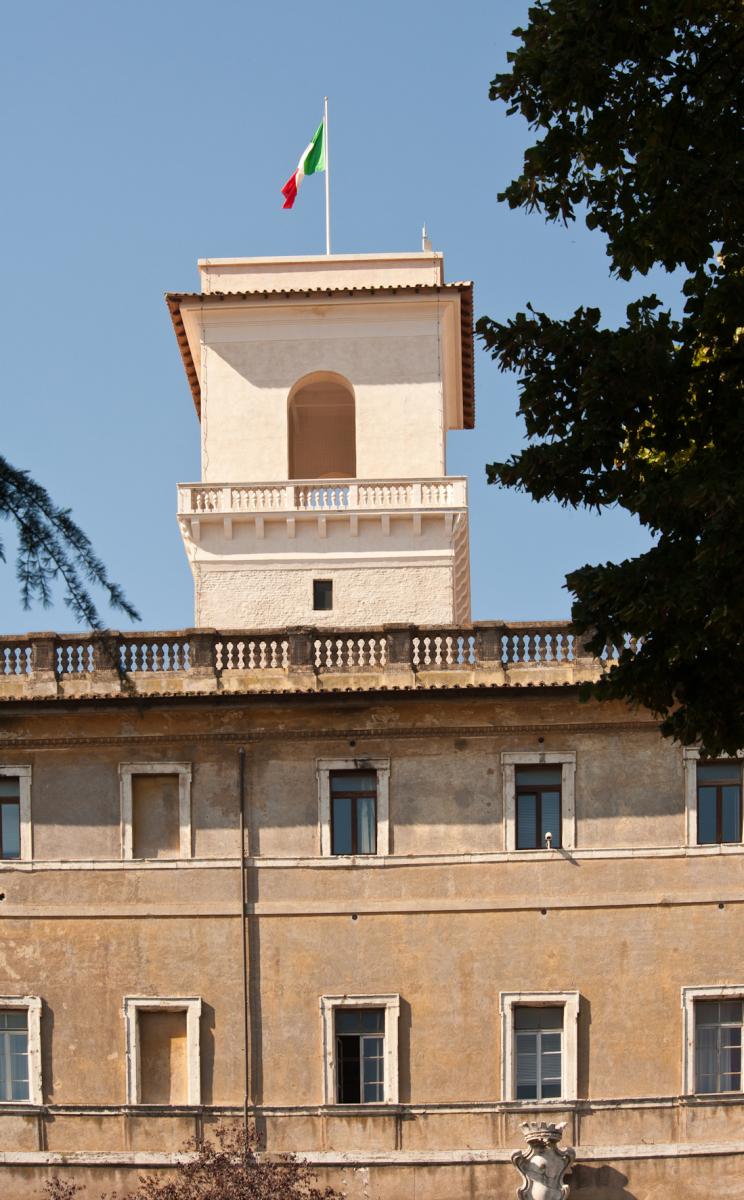 It was built in the XVI century on a big fort, in a very old building, but it dates back
It was built in the XVI century on a big fort, in a very old building, but it dates back to the XIII century. In its rooms there are beautiful decorations typical of the Renaissance style, and different coats of arms from the popes, the Medicis and the Orsinis. Since 1890 it has been the palace of the administration of the town. After an earthquake in 1915 it was rebuilt. There are two doors leading to the big internal garden. The garden has columns with lots of decorations and the symbol of the Grillo family. In the mayor’s office there are interesting paintings. The second courtyard is called “cortile del pozzo”, because there is a big tank built in the XVI century by a Roman artist.
to the XIII century. In its rooms there are beautiful decorations typical of the Renaissance style, and different coats of arms from the popes, the Medicis and the Orsinis. Since 1890 it has been the palace of the administration of the town. After an earthquake in 1915 it was rebuilt. There are two doors leading to the big internal garden. The garden has columns with lots of decorations and the symbol of the Grillo family. In the mayor’s office there are interesting paintings. The second courtyard is called “cortile del pozzo”, because there is a big tank built in the XVI century by a Roman artist.
 It was built in the XVI century on a big fort, in a very old building, but it dates back
It was built in the XVI century on a big fort, in a very old building, but it dates back to the XIII century. In its rooms there are beautiful decorations typical of the Renaissance style, and different coats of arms from the popes, the Medicis and the Orsinis. Since 1890 it has been the palace of the administration of the town. After an earthquake in 1915 it was rebuilt. There are two doors leading to the big internal garden. The garden has columns with lots of decorations and the symbol of the Grillo family. In the mayor’s office there are interesting paintings. The second courtyard is called “cortile del pozzo”, because there is a big tank built in the XVI century by a Roman artist.
to the XIII century. In its rooms there are beautiful decorations typical of the Renaissance style, and different coats of arms from the popes, the Medicis and the Orsinis. Since 1890 it has been the palace of the administration of the town. After an earthquake in 1915 it was rebuilt. There are two doors leading to the big internal garden. The garden has columns with lots of decorations and the symbol of the Grillo family. In the mayor’s office there are interesting paintings. The second courtyard is called “cortile del pozzo”, because there is a big tank built in the XVI century by a Roman artist. Porta Garibaldi
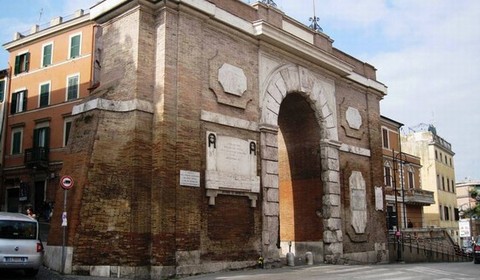 Designed by the Roman architect Frontoni in 1722, it was part of the wall that closed the town. It is the last of the four doors leading to the centre of the town. This door is a national monument: it was called “porta romana” before 1870, it was named “porta Garibaldi” after the conquest by Garibaldi. In order to enter the town, coming from the Tiber valley, Garibaldi had to burn the door that closed the access to the centre of the town.
Designed by the Roman architect Frontoni in 1722, it was part of the wall that closed the town. It is the last of the four doors leading to the centre of the town. This door is a national monument: it was called “porta romana” before 1870, it was named “porta Garibaldi” after the conquest by Garibaldi. In order to enter the town, coming from the Tiber valley, Garibaldi had to burn the door that closed the access to the centre of the town.
On the top of the door there are two flags, the Italian flag and the European flag.
 Designed by the Roman architect Frontoni in 1722, it was part of the wall that closed the town. It is the last of the four doors leading to the centre of the town. This door is a national monument: it was called “porta romana” before 1870, it was named “porta Garibaldi” after the conquest by Garibaldi. In order to enter the town, coming from the Tiber valley, Garibaldi had to burn the door that closed the access to the centre of the town.
Designed by the Roman architect Frontoni in 1722, it was part of the wall that closed the town. It is the last of the four doors leading to the centre of the town. This door is a national monument: it was called “porta romana” before 1870, it was named “porta Garibaldi” after the conquest by Garibaldi. In order to enter the town, coming from the Tiber valley, Garibaldi had to burn the door that closed the access to the centre of the town.On the top of the door there are two flags, the Italian flag and the European flag.
Garibaldi: Giuseppe Garibaldi (Nice, July 1807 – Caprera, June 1882) was a general and a patriot. He is one of the most celebrated Italian characters, famous all over the world, and he is also a national hero.
Fontana dei Leoni
 It is in piazza dei Leoni and it was built in 1845 by Cardinal Lambruschini as the symbol of the town of Monterotondo. Above the four lions in terra-cotta there is a column.
It is in piazza dei Leoni and it was built in 1845 by Cardinal Lambruschini as the symbol of the town of Monterotondo. Above the four lions in terra-cotta there is a column.
 It is in piazza dei Leoni and it was built in 1845 by Cardinal Lambruschini as the symbol of the town of Monterotondo. Above the four lions in terra-cotta there is a column.
It is in piazza dei Leoni and it was built in 1845 by Cardinal Lambruschini as the symbol of the town of Monterotondo. Above the four lions in terra-cotta there is a column.THE PLACES
Piazza dei Leoni
 Piazza dei Leoni is the heart of ancient Monterotondo. It was originally called “piazza del Popolo”. Later the square was called “piazza dei Leoni” because in the centre there is a fountain with the sculptures of four lions.
Piazza dei Leoni is the heart of ancient Monterotondo. It was originally called “piazza del Popolo”. Later the square was called “piazza dei Leoni” because in the centre there is a fountain with the sculptures of four lions.Lots of shops open on the square, as well as a restaurant, a coffee bar and a bookshop. Next to “piazza dei Leoni” there is a building where Garibaldi talked to people.
Via Cavour
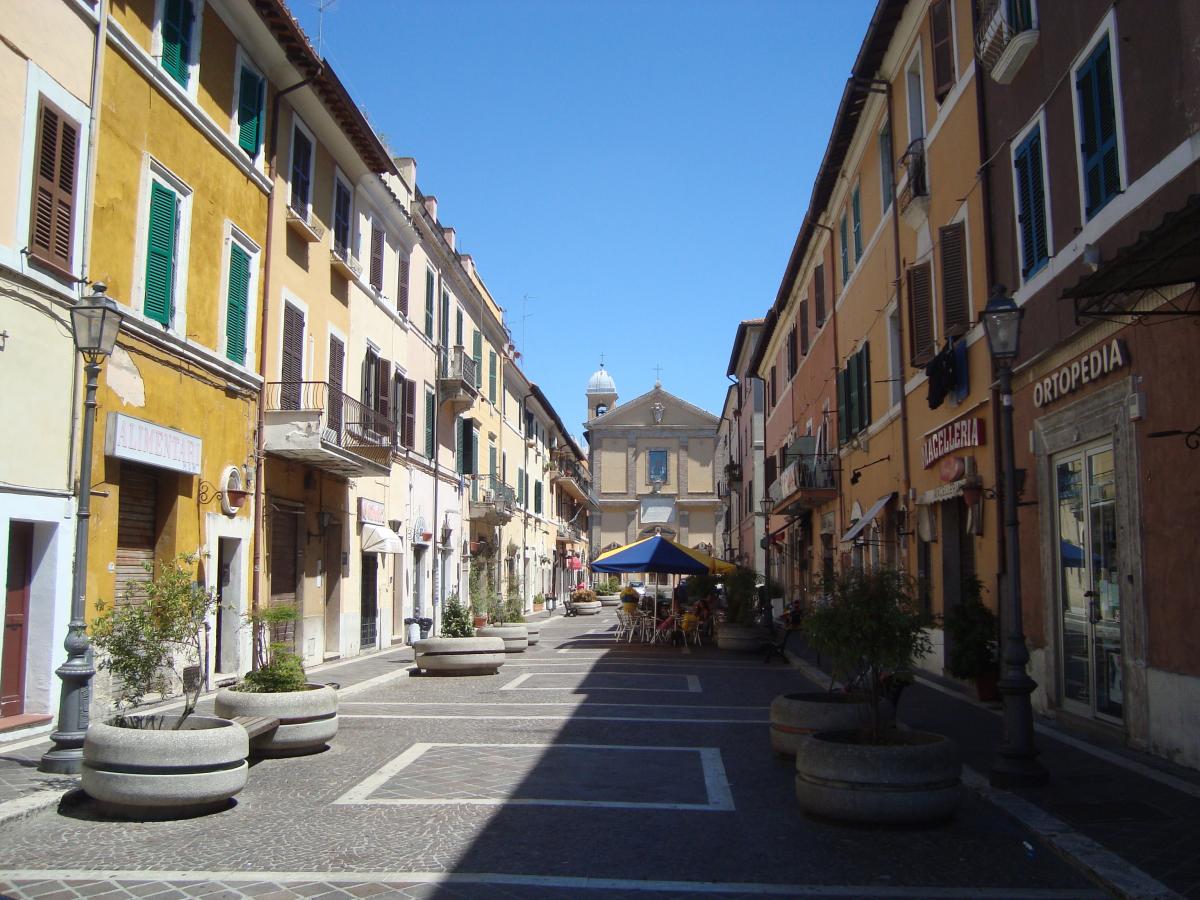
Via Cavour is an important street in Monterotondo because it links the dome to piazza dei Leoni. It has got a lot of shops: there is a fishmonger’s, three coffee bars, two clothes’ shops, two hairstylists’, one butcher’s, one news-stand’s and one food market.
Il Giardino del Cigno
In front of the Town Hall there is “Giardino del Cigno”: it is a round park, surrounded by high plants and bushes, with lots of beautiful flowers. In this park you can practice different activities, like running, walking along its paths, riding a bike, studying or just sitting in the sun. In the centre of the garden there is a fountain, called “Fontana del Cigno”, because it is characterized by a statue of a man with a swan pulling out water from its beak. In the garden there is also a monument in honour of the dead during the 1st World War.

THE CELEBRATIONS
Saint Anthony Abbot
On Sunday 17th January we celebrate St. Anthony Abbot. He is the protector of all animals. In the morning, people take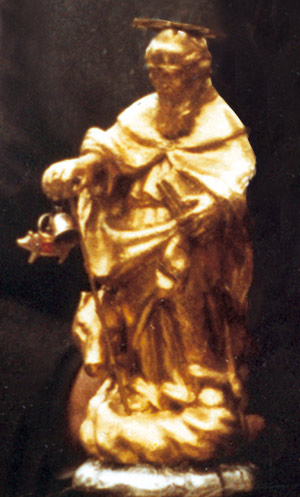 their horses in front of the cathedral. In the evening there is the “torciata”, where people walk in Monterotondo with a torch, wearing a black and red cap. This celebration is called “la festa dei mulattieri”; the “torciata” lasts about two hours and it ends up in the new owner’s house who offers a little buffet to the participants and lets the door open to all faithful who want to visit the statue of St. Anthony.
their horses in front of the cathedral. In the evening there is the “torciata”, where people walk in Monterotondo with a torch, wearing a black and red cap. This celebration is called “la festa dei mulattieri”; the “torciata” lasts about two hours and it ends up in the new owner’s house who offers a little buffet to the participants and lets the door open to all faithful who want to visit the statue of St. Anthony.
On Sunday 17th January we celebrate St. Anthony Abbot. He is the protector of all animals. In the morning, people take
 their horses in front of the cathedral. In the evening there is the “torciata”, where people walk in Monterotondo with a torch, wearing a black and red cap. This celebration is called “la festa dei mulattieri”; the “torciata” lasts about two hours and it ends up in the new owner’s house who offers a little buffet to the participants and lets the door open to all faithful who want to visit the statue of St. Anthony.
their horses in front of the cathedral. In the evening there is the “torciata”, where people walk in Monterotondo with a torch, wearing a black and red cap. This celebration is called “la festa dei mulattieri”; the “torciata” lasts about two hours and it ends up in the new owner’s house who offers a little buffet to the participants and lets the door open to all faithful who want to visit the statue of St. Anthony.Ciummacata
 We celebrate “Ciummacata” on the 24th June: people meet in front of the cathedral and eat snails, the typical meal on this day. During the evening, they listen to music played by different bands, dance and have fun. At midnight they burn a witch, the symbol of the end of the winter and the coming of the summer.
We celebrate “Ciummacata” on the 24th June: people meet in front of the cathedral and eat snails, the typical meal on this day. During the evening, they listen to music played by different bands, dance and have fun. At midnight they burn a witch, the symbol of the end of the winter and the coming of the summer.
 We celebrate “Ciummacata” on the 24th June: people meet in front of the cathedral and eat snails, the typical meal on this day. During the evening, they listen to music played by different bands, dance and have fun. At midnight they burn a witch, the symbol of the end of the winter and the coming of the summer.
We celebrate “Ciummacata” on the 24th June: people meet in front of the cathedral and eat snails, the typical meal on this day. During the evening, they listen to music played by different bands, dance and have fun. At midnight they burn a witch, the symbol of the end of the winter and the coming of the summer.THE HISTORICAL CHARACTERS
Bruno Buozzi
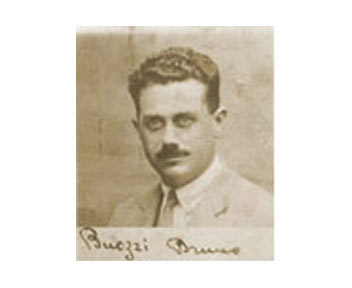 Bruno Buozzi was born on 31st January 1881 and he was murdered by German soldiers in Rome on the 4th June 1944. During fascism he had been elected Commissioner of the Industrial Trade Union. When Rome was occupied by the Nazi, Bruno Buozzi took refuge in some places, but finally he was surprised by the Germans. He was imprisoned and in June 1944 he was killed with other prisoners at “La Storta” near Rome. After his death a lot of roads, squares and schools have been named after Bruno Buozzi all over Italy.
Bruno Buozzi was born on 31st January 1881 and he was murdered by German soldiers in Rome on the 4th June 1944. During fascism he had been elected Commissioner of the Industrial Trade Union. When Rome was occupied by the Nazi, Bruno Buozzi took refuge in some places, but finally he was surprised by the Germans. He was imprisoned and in June 1944 he was killed with other prisoners at “La Storta” near Rome. After his death a lot of roads, squares and schools have been named after Bruno Buozzi all over Italy.
 Bruno Buozzi was born on 31st January 1881 and he was murdered by German soldiers in Rome on the 4th June 1944. During fascism he had been elected Commissioner of the Industrial Trade Union. When Rome was occupied by the Nazi, Bruno Buozzi took refuge in some places, but finally he was surprised by the Germans. He was imprisoned and in June 1944 he was killed with other prisoners at “La Storta” near Rome. After his death a lot of roads, squares and schools have been named after Bruno Buozzi all over Italy.
Bruno Buozzi was born on 31st January 1881 and he was murdered by German soldiers in Rome on the 4th June 1944. During fascism he had been elected Commissioner of the Industrial Trade Union. When Rome was occupied by the Nazi, Bruno Buozzi took refuge in some places, but finally he was surprised by the Germans. He was imprisoned and in June 1944 he was killed with other prisoners at “La Storta” near Rome. After his death a lot of roads, squares and schools have been named after Bruno Buozzi all over Italy.RECIPES
Ciambelle a zampa
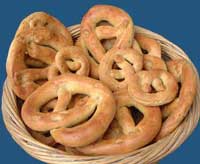 Ingredients:
Ingredients:
• 1 kg flour;
• 33 cl white wine;
• 3 spoons salt;
• 3 spoons aniseed.
Procedure:
Heat the wine with the aniseed. Mix the ingredients until soft. Divide the mixture into nine parts, make ring-shaped cakes and boil them. Let them dry for about 90 minutes. Bake them for about 60 minutes.
 Ingredients:
Ingredients:• 1 kg flour;
• 33 cl white wine;
• 3 spoons salt;
• 3 spoons aniseed.
Procedure:
Heat the wine with the aniseed. Mix the ingredients until soft. Divide the mixture into nine parts, make ring-shaped cakes and boil them. Let them dry for about 90 minutes. Bake them for about 60 minutes.
Tozzetti
 Ingredients:
Ingredients:
• 2 eggs;
• 200 gr sugar;
• 1 glass white wine;
• baking powder;
• 1 lemon (grated peel);
• 400 gr flour;
• hazel-nuts.
Procedure:
Beat the eggs with the sugar until soft. Add the flour and the other ingredients and make thin rolls from the mixture. Bake them for about 20 minutes. Cut them into small pieces and bake them again for about 15 minutes. Place them on a grill and let them cool.
 Ingredients:
Ingredients:• 2 eggs;
• 200 gr sugar;
• 1 glass white wine;
• baking powder;
• 1 lemon (grated peel);
• 400 gr flour;
• hazel-nuts.
Procedure:
Beat the eggs with the sugar until soft. Add the flour and the other ingredients and make thin rolls from the mixture. Bake them for about 20 minutes. Cut them into small pieces and bake them again for about 15 minutes. Place them on a grill and let them cool.
Sito realizzato e distribuito da Porte Aperte sul Web, Comunità di pratica per l'accessibilità dei siti scolastici, nell'ambito del Progetto "Un CMS per la scuola"-USR Lombardia.
Il modello di sito è rilasciato sotto licenza Attribuzione-Non commerciale-Condividi allo stesso modo 3.0 Unported di Creative Commons.
Installazione, aggiornamenti e modifiche a cura di Vincenzo La Rosa (I.C. Monterotondo Via B. Buozzi)





